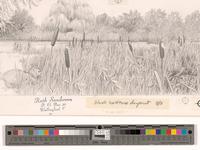For more than 25 years, libraries have been digitizing their collections, and the Free Library has digital collections in abundance—providing the opportunity to browse through roughly 50,000 images or to take a deep dive into the topic of your choice, be it Medieval Manuscripts, Historical Images of Philadelphia, or Pennsylvania German Fraktur.
The Free Library began its digitization efforts with a grant from the Institute for Museum and Library Services (IMLS) to digitize its collection of photographs from the United States Centennial Exhibition held in Philadelphia in 1876. Housed in the Print and Picture Collection, these stunning silver albumen prints are the official photographs of the Centennial and document the buildings—an astonishing array of mostly temporary structures erected in West Fairmount Park—and the exhibits, from nearly every country around the globe displaying their decorative art, technology, food products, and all manner of innovations. Besides the photographs, other related visual materials (like sheet music and even a diary of a young man who attended) were digitized and an exhaustive narrative was developed to give context to the objects. The project was completed in 2000.
One of the stated goals in obtaining that first grant from IMLS was to build the Free Library’s capacity to digitize. WIth the scanning equipment, trained and skilled staff, database architecture, and user interface all in place, we were ready to embark upon the next effort—celebrating the 75th anniversary of the Parkway Central Library building. This project brought together archives and artifacts from the Free Library’s history; photographs of the main players, including the architects and politicians; drawings from the planning phase of the building; and photographs of the work as it was being done. This digital collection was accompanied by a physical exhibition in the lobby of Parkway Central and a walking tour of the building keyed to some of the historic photographs.
Following up on the 75th, we set about digitizing Historical Images of Philadelphia (HIP), photographs from the Print and Picture Collection that document the city's past through its neighborhoods, buildings, and events. The images are placed in the context of the early development of photography with information on the photographers and photographic processes in addition to being arranged by neighborhood. HIP now contains nearly 13,000 images and a Map Overalay Tool has also been added to illustrate how Philadelphia has changed over time through historic maps from the Map Collection.
By 2004, the above three initiatives had checked off some priority collections with high marks for broad interest, visual appeal, uniqueness, research value, and no copyright issues. Another collection on the list of priorities was the Rare Book Department’s collection of Medieval and Renaissance manuscripts, one of the finest and largest in a public library. While the collection was not very well known locally, scholars had been clamoring for better access to it for years and a 2002 exhibition, Leaves of Gold, had thrust it into the spotlight. Another application to the IMLS brought support to digitize 3,055 images from 1,400 historically significant manuscript leaves and codices.
In 2009, the Free Library received funding from the Barra Foundation to digitize the Rare Book Department's collection of Fraktur, manuscript art produced by Pennsylvania Germans in the 1700s and 1800s. A few years later the National Endowment for the Humanities awarded the Free Library a Save America’s Treasures grant to conserve and digitize Pennsylvania German manuscripts, which represent the everyday lives of Pennsylvania Germans through music notebooks, business ledgers, weaving pattern books, and collections of home remedies.
In the meantime, other collections came online with images curated by staff representing the Children’s Literature Research Collection, the Fleisher Collection, Maps, and Theatre, as well as an assortment from the Rare Book Department and Print and Picture Collection. In the past several years, the Free Library has been a leader in important collaborative projects: Bibliotheca Philadelphiensis digitized virtually all of the medieval and Renaissance manuscripts in the Philadelphia region. A current three-year project, Manuscripts of the Muslim World, is digitizing the Islamicate manuscripts from the Free Library, Bryn Mawr College, Columbia University, Haverford College, and the University of Pennsylvania. Both of these efforts are supported by the Council for Library and Information Resources, Digitizing Hidden Collections Archives with funding from the Mellon Foundation.
Recently, the Collection Care Department unveiled a new Center for Digitization as part of the Free Library's Building Inspiration: 21st Century Libraries initiative. Work continues with state of the art equipment to digitize collection items, including the Rare Book Department’s First Folio of William Shakespeare work, with annotations by the English poet John Milton.
Although we may be closed now, the Free Library’s Digital Collections are always open. During the temporary closure, Special Collections Curators and Librarians are available via eref to answer questions you may have about items in our collections. Contact information is located on the individual Department pages.
Have a question for Free Library staff? Please submit it to our Ask a Librarian page and receive a response within two business days.




.jpg)